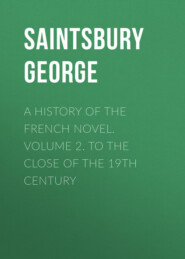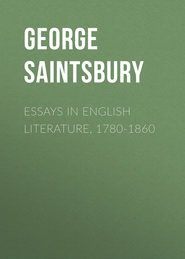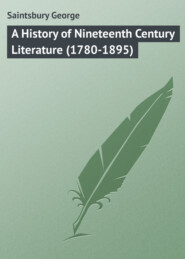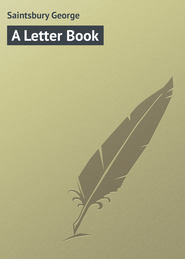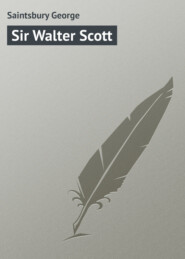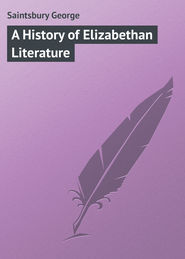По всем вопросам обращайтесь на: info@litportal.ru
(©) 2003-2024.
✖
A Short History of French Literature
Настройки чтения
Размер шрифта
Высота строк
Поля
Ed. Michel. Paris, 1839.
36
Ed. Schéler. Brussels, 1874.
37
Ed. Pey. Paris, 1859.
38
Ed. Tarbé. Rheims, 1850.
39
Ed. Michel. London, 1836.
40
It is very commonly said that this feature is confined to the later Chansons. This is scarcely the fact, unless by 'later' we are to understand all except Roland. In Roland itself the presentment is by no means wholly complimentary.
41
The Turoldus of Roland has been already noticed. Of certain or tolerably certain authors, Graindor de Douai (revisions of the early crusading Chansons of 'Richard the Pilgrim,' Antioche, &c.), Jean de Flagy (Garin), Bodel (Les Saisnes), and Adenès le Roi, a fertile author or adapter of the thirteenth century, are the most noted.
42
Ferabras and Betonnet d'Hanstone. M. Paul Meyer has recently edited this latter poem under the title of Daurel et Beton (Paris, 1880). To these should be added a fragment, Aigar et Maurin, which seems to rank with Girartz.
43
There has been some reaction of late years against the scepticism which questioned the 'Provençal Epic.' I cannot however say, though I admit a certain disqualification for judgment (see note at beginning of next chapter), that I see any valid reason for this reaction.
44
Oc and oil (hoc and hoc illud), the respective terms indicating affirmation. In this chapter the information given is based on a smaller acquaintance at first hand with the subject than is the case in the chapters on French proper. Herr Karl Bartsch has been the guide chiefly followed.
45
Essay on Ranke's History of the Popes.
46
See chap. i.
47
See chap. x.
48
The poem on Boethius. See chap. i.
49
By the school of the so-called Félibres, of whom Mistral and Aubanel are the chief.
50
Moland and Héricault's Introduction to Aucassin et Nicolette. Paris, 1856.
51
Nennius, a Breton monk of the ninth century, has left a brief Latin Chronicle in which is the earliest authentic account of the Legend of Arthur. Geoffrey of Monmouth, circa 1140, produced a Historia Britonum, avowedly based on a book brought from Britanny by Walter, Archdeacon of Oxford. No trace of this book, unless it be Nennius, can be found. See note at end of chapter.
52
Department of Seine-et-Marne, near Fontainebleau.
53
Map as a person belongs rather to English than to French history. He lived in the last three quarters of the twelfth century.
54
These various Romances are not by any means equally open to study in satisfactory critical editions. To take them chronologically, M. Hucher has published Robert de Borron's Little Saint Graal in prose, his Percevale, and the Great Saint Graal, with full and valuable if not incontestable notes, 3 vols.; Le Mans, 1875-1878. The verse form of the Little Saint Graal was published by M. F. Michel in 1841. An edition of Artus was promised by M. Paulin Paris, but interrupted or prevented by his death. The great works of Map, Lancelot and the Quest, as well as the Mort Artus, have never been critically edited in full; and the sixteenth-century editions being rare and exceedingly costly, as well as uncritical, they are not easily accessible, except in M. Paris' Abstract and Commentary, Les Romans de la Table Ronde, 5 vols., 1869-1877. Tristan was published partially forty years ago by M. F. Michel. Merlin was edited in 1886 by M. G. Paris and M. Ulrich. A complete edition of Chrestien de Troyes has been undertaken by Dr. Wendelin Förster and has preceded to its second volume (Yvain). This under its second title of Le Chevalier au Lyon has also been edited by Dr. Holland (third edition 1886). Besides this there is the great Romance of Percevale (continued by others, especially a certain Manessier), of which M. Potvin has given an excellent edition, 6 vols., Mons, 1867-1872, including in it a previously unknown prose version of the Romance of very early date; Le Chevalier à la Charrette, continued by Godefroy de Lagny, and edited, with the original prose from Lancelot du Lac, by Dr. Jonckbloet (The Hague, 1850); and Erec et Énide, by M. Haupt (Berlin, 1860). This piecemeal condition of the texts, and the practical inaccessibility of many of them, make independent judgment in the matter very difficult. What is wanted first of all is a book on the plan of M. Léon Gautier's Epopées Françaises, giving a complete account of all the existing texts – for the entire editing of these latter must necessarily take a very long time. The statements made above represent the opinions which appear most probable to the writer, not merely from the comparison of authorities on the subject, but from the actual study of the texts as far as they are open to him. (See note at end of Chapter.)
55
This expression occurs in the Chanson des Saisnes, i. 6. 7: 'Ne sont que iij matières a nul home atandant, De France et de Bretaigne et de Rome la grant.'
56
Ed. Michelant. Stuttgart, 1846.
57
Li Cors, otherwise li tors 'the crooked.' Since this book was first written M. Paul Meyer has treated the whole subject of the paragraph in an admirable monograph, Alexandre le Grand dans la Littérature Française du Moyen Age, 2 vols. Paris, 1886.
58
Ed. Joly. Rouen, 1870.
59
Moland and Héricault's Nouvelles du XIVème Siècle. Paris, 1857. Joly, Op. cit. See also P. Stapfer, Shakespeare et l'Antiquité. 2 vols. Paris, 1880.
60
36
Ed. Schéler. Brussels, 1874.
37
Ed. Pey. Paris, 1859.
38
Ed. Tarbé. Rheims, 1850.
39
Ed. Michel. London, 1836.
40
It is very commonly said that this feature is confined to the later Chansons. This is scarcely the fact, unless by 'later' we are to understand all except Roland. In Roland itself the presentment is by no means wholly complimentary.
41
The Turoldus of Roland has been already noticed. Of certain or tolerably certain authors, Graindor de Douai (revisions of the early crusading Chansons of 'Richard the Pilgrim,' Antioche, &c.), Jean de Flagy (Garin), Bodel (Les Saisnes), and Adenès le Roi, a fertile author or adapter of the thirteenth century, are the most noted.
42
Ferabras and Betonnet d'Hanstone. M. Paul Meyer has recently edited this latter poem under the title of Daurel et Beton (Paris, 1880). To these should be added a fragment, Aigar et Maurin, which seems to rank with Girartz.
43
There has been some reaction of late years against the scepticism which questioned the 'Provençal Epic.' I cannot however say, though I admit a certain disqualification for judgment (see note at beginning of next chapter), that I see any valid reason for this reaction.
44
Oc and oil (hoc and hoc illud), the respective terms indicating affirmation. In this chapter the information given is based on a smaller acquaintance at first hand with the subject than is the case in the chapters on French proper. Herr Karl Bartsch has been the guide chiefly followed.
45
Essay on Ranke's History of the Popes.
46
See chap. i.
47
See chap. x.
48
The poem on Boethius. See chap. i.
49
By the school of the so-called Félibres, of whom Mistral and Aubanel are the chief.
50
Moland and Héricault's Introduction to Aucassin et Nicolette. Paris, 1856.
51
Nennius, a Breton monk of the ninth century, has left a brief Latin Chronicle in which is the earliest authentic account of the Legend of Arthur. Geoffrey of Monmouth, circa 1140, produced a Historia Britonum, avowedly based on a book brought from Britanny by Walter, Archdeacon of Oxford. No trace of this book, unless it be Nennius, can be found. See note at end of chapter.
52
Department of Seine-et-Marne, near Fontainebleau.
53
Map as a person belongs rather to English than to French history. He lived in the last three quarters of the twelfth century.
54
These various Romances are not by any means equally open to study in satisfactory critical editions. To take them chronologically, M. Hucher has published Robert de Borron's Little Saint Graal in prose, his Percevale, and the Great Saint Graal, with full and valuable if not incontestable notes, 3 vols.; Le Mans, 1875-1878. The verse form of the Little Saint Graal was published by M. F. Michel in 1841. An edition of Artus was promised by M. Paulin Paris, but interrupted or prevented by his death. The great works of Map, Lancelot and the Quest, as well as the Mort Artus, have never been critically edited in full; and the sixteenth-century editions being rare and exceedingly costly, as well as uncritical, they are not easily accessible, except in M. Paris' Abstract and Commentary, Les Romans de la Table Ronde, 5 vols., 1869-1877. Tristan was published partially forty years ago by M. F. Michel. Merlin was edited in 1886 by M. G. Paris and M. Ulrich. A complete edition of Chrestien de Troyes has been undertaken by Dr. Wendelin Förster and has preceded to its second volume (Yvain). This under its second title of Le Chevalier au Lyon has also been edited by Dr. Holland (third edition 1886). Besides this there is the great Romance of Percevale (continued by others, especially a certain Manessier), of which M. Potvin has given an excellent edition, 6 vols., Mons, 1867-1872, including in it a previously unknown prose version of the Romance of very early date; Le Chevalier à la Charrette, continued by Godefroy de Lagny, and edited, with the original prose from Lancelot du Lac, by Dr. Jonckbloet (The Hague, 1850); and Erec et Énide, by M. Haupt (Berlin, 1860). This piecemeal condition of the texts, and the practical inaccessibility of many of them, make independent judgment in the matter very difficult. What is wanted first of all is a book on the plan of M. Léon Gautier's Epopées Françaises, giving a complete account of all the existing texts – for the entire editing of these latter must necessarily take a very long time. The statements made above represent the opinions which appear most probable to the writer, not merely from the comparison of authorities on the subject, but from the actual study of the texts as far as they are open to him. (See note at end of Chapter.)
55
This expression occurs in the Chanson des Saisnes, i. 6. 7: 'Ne sont que iij matières a nul home atandant, De France et de Bretaigne et de Rome la grant.'
56
Ed. Michelant. Stuttgart, 1846.
57
Li Cors, otherwise li tors 'the crooked.' Since this book was first written M. Paul Meyer has treated the whole subject of the paragraph in an admirable monograph, Alexandre le Grand dans la Littérature Française du Moyen Age, 2 vols. Paris, 1886.
58
Ed. Joly. Rouen, 1870.
59
Moland and Héricault's Nouvelles du XIVème Siècle. Paris, 1857. Joly, Op. cit. See also P. Stapfer, Shakespeare et l'Antiquité. 2 vols. Paris, 1880.
60






